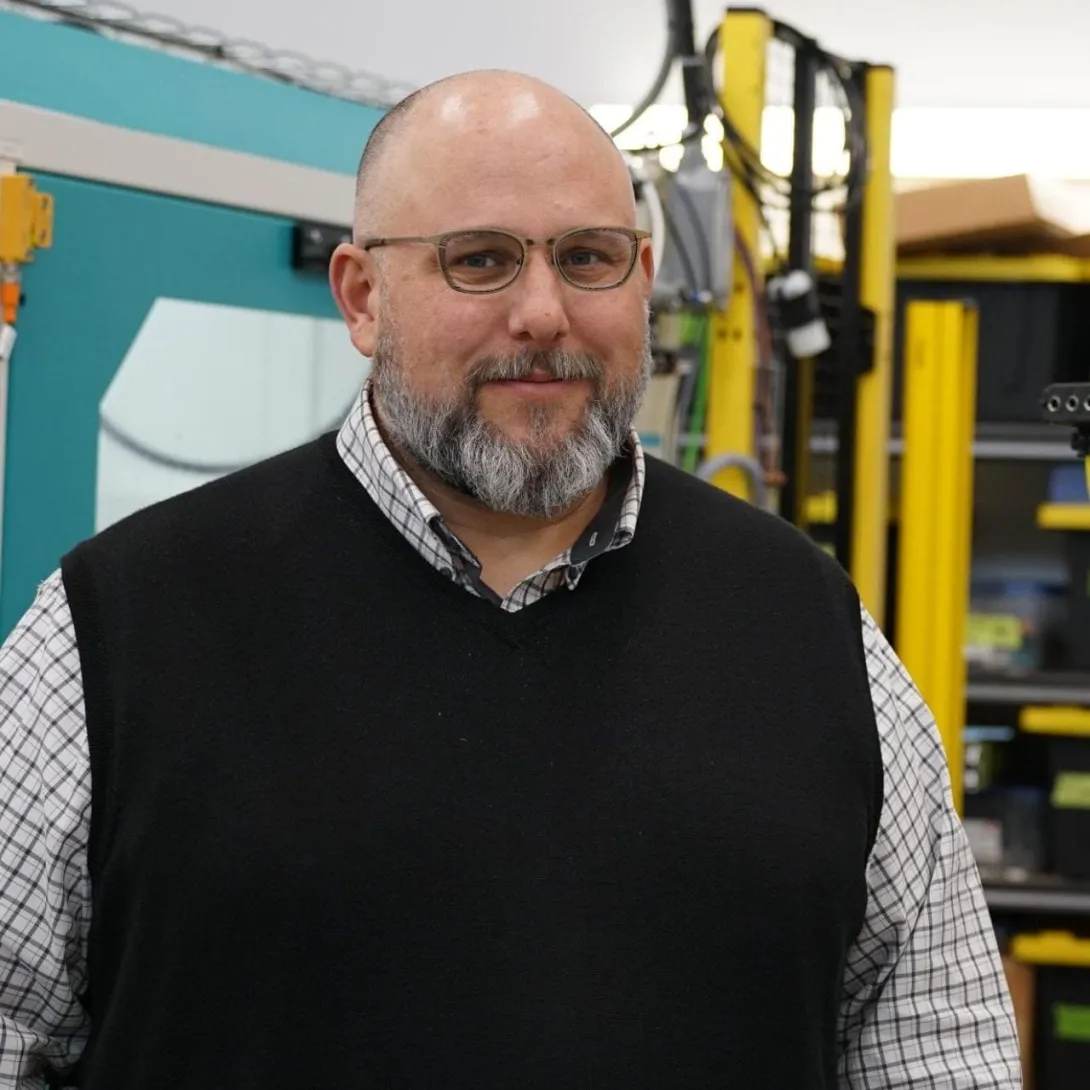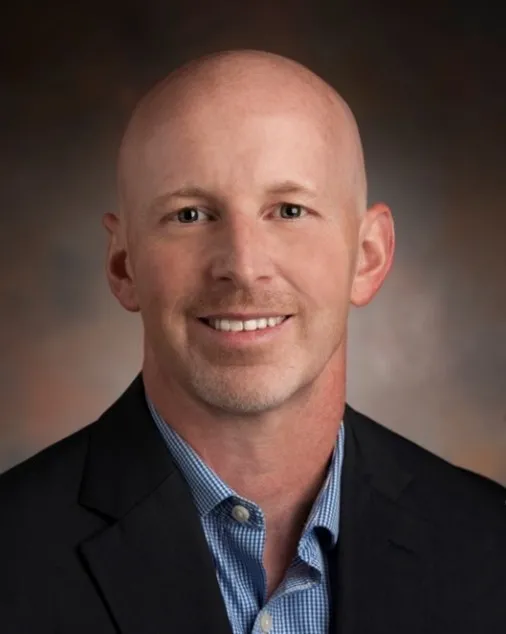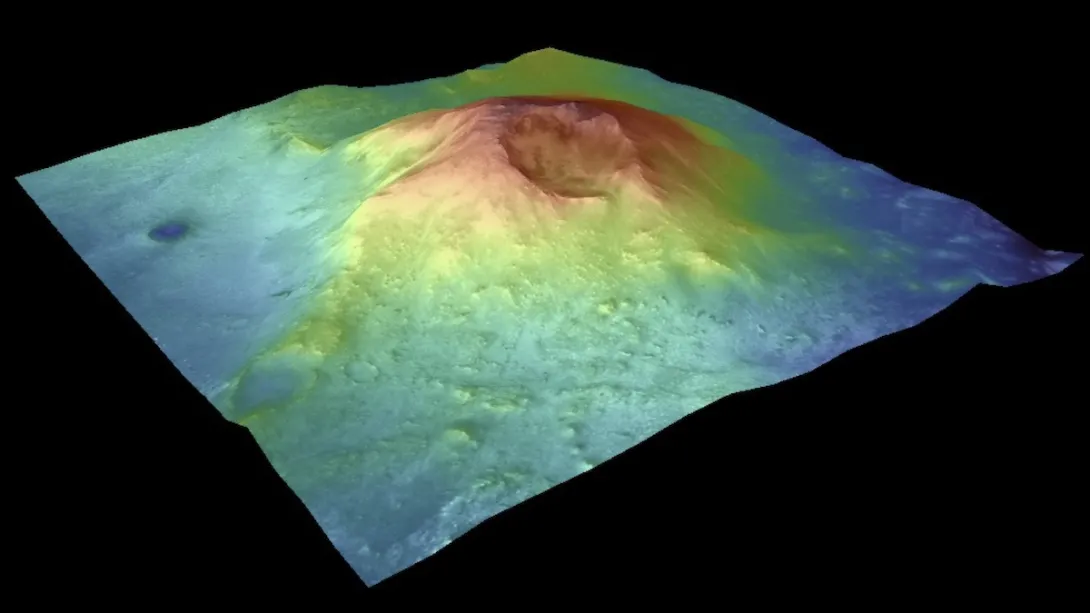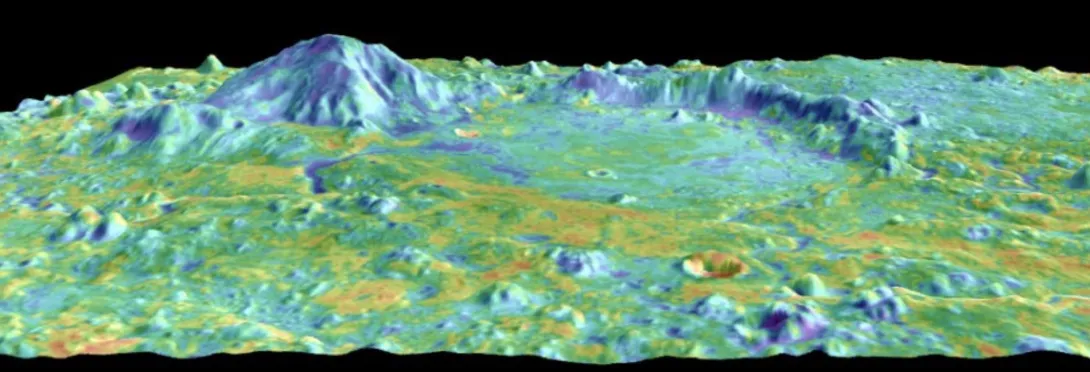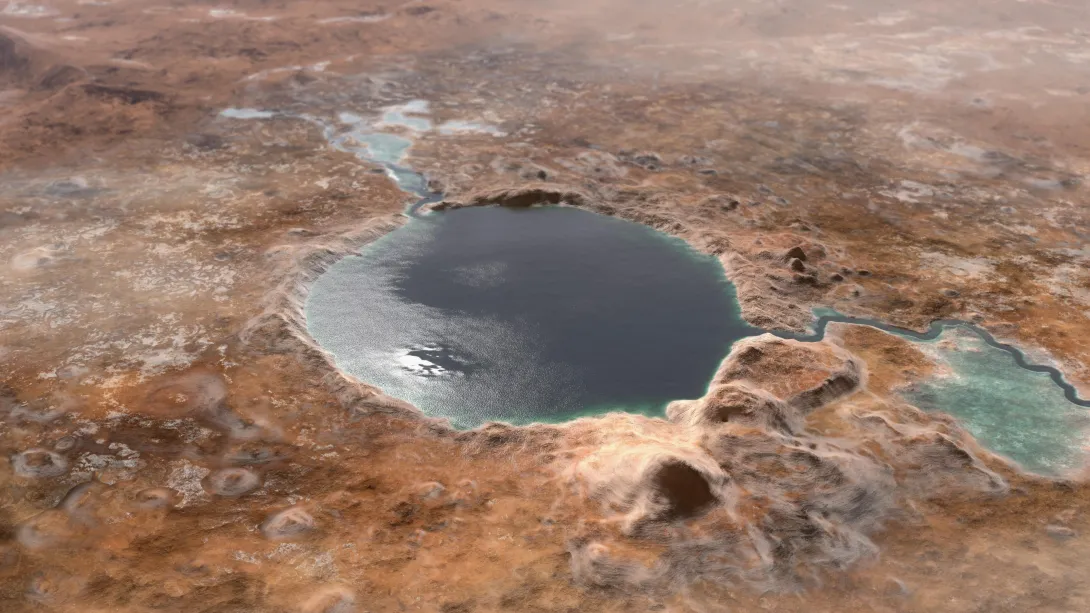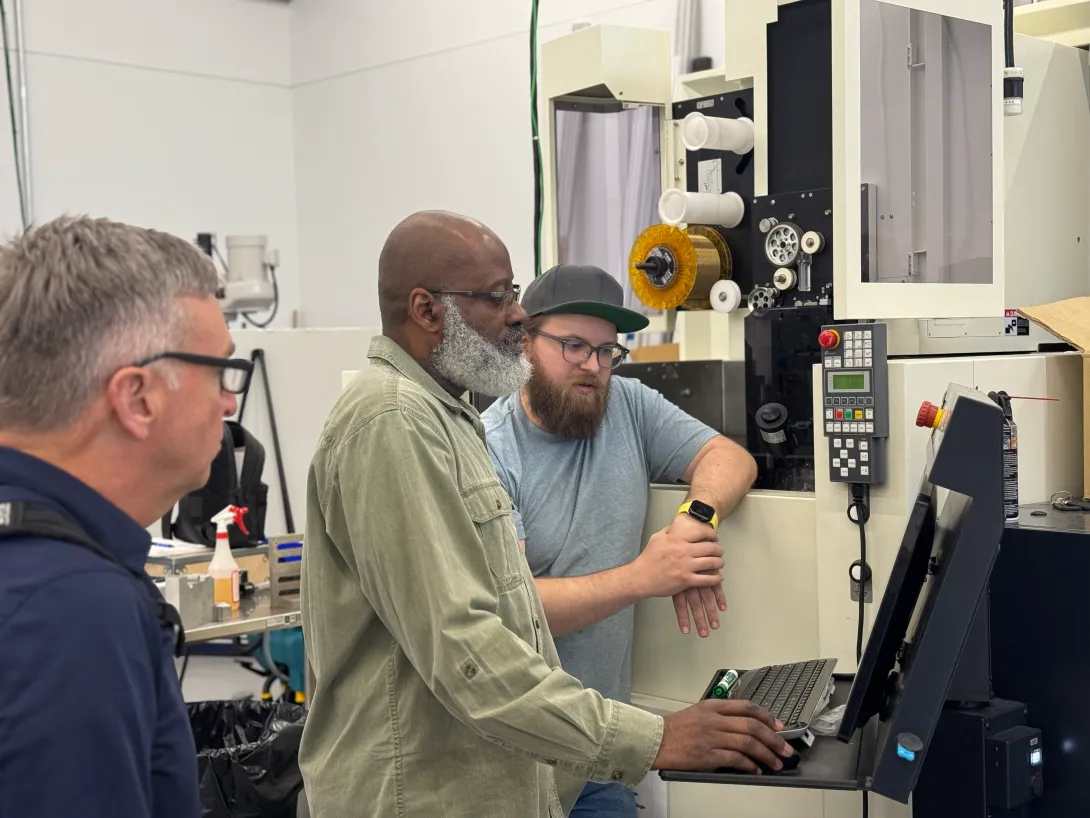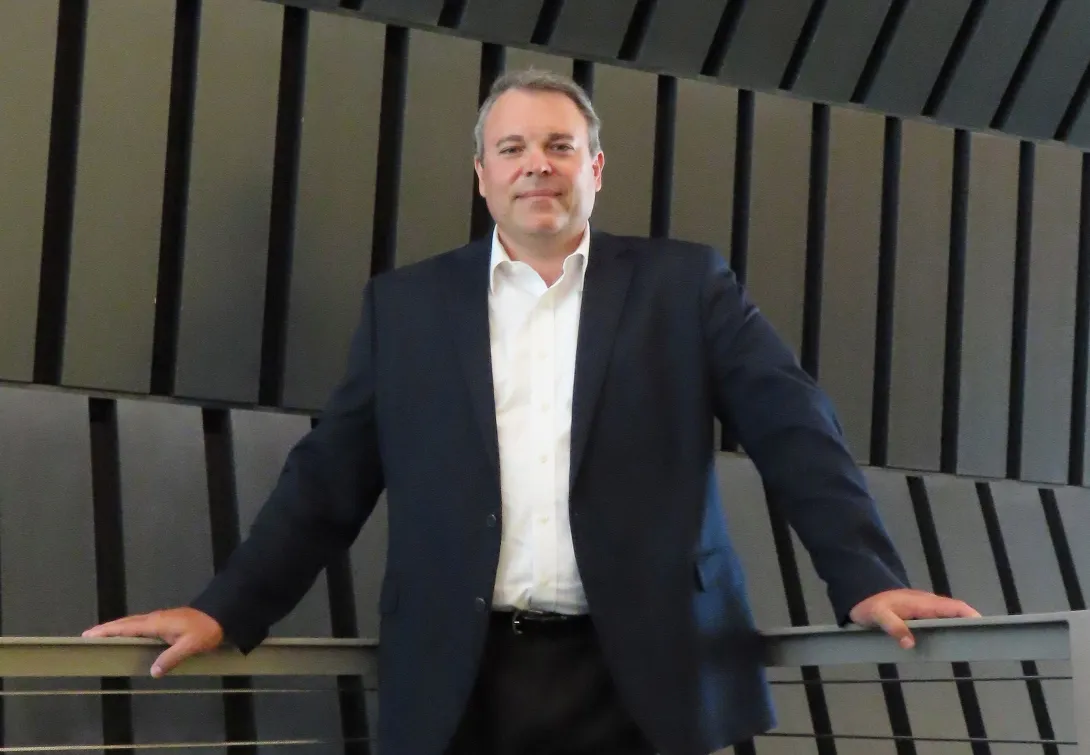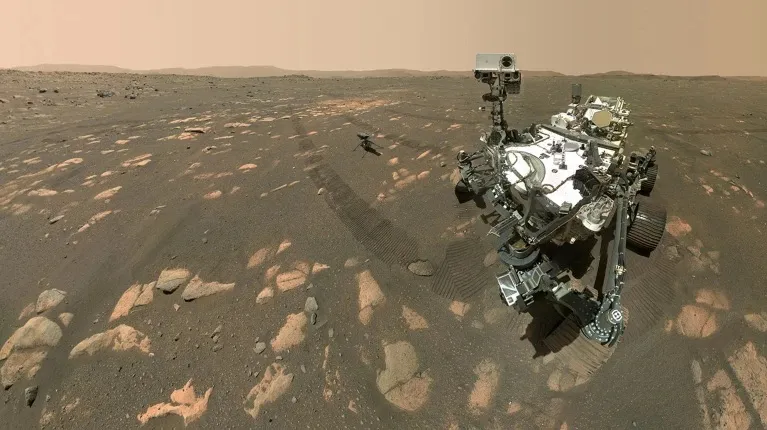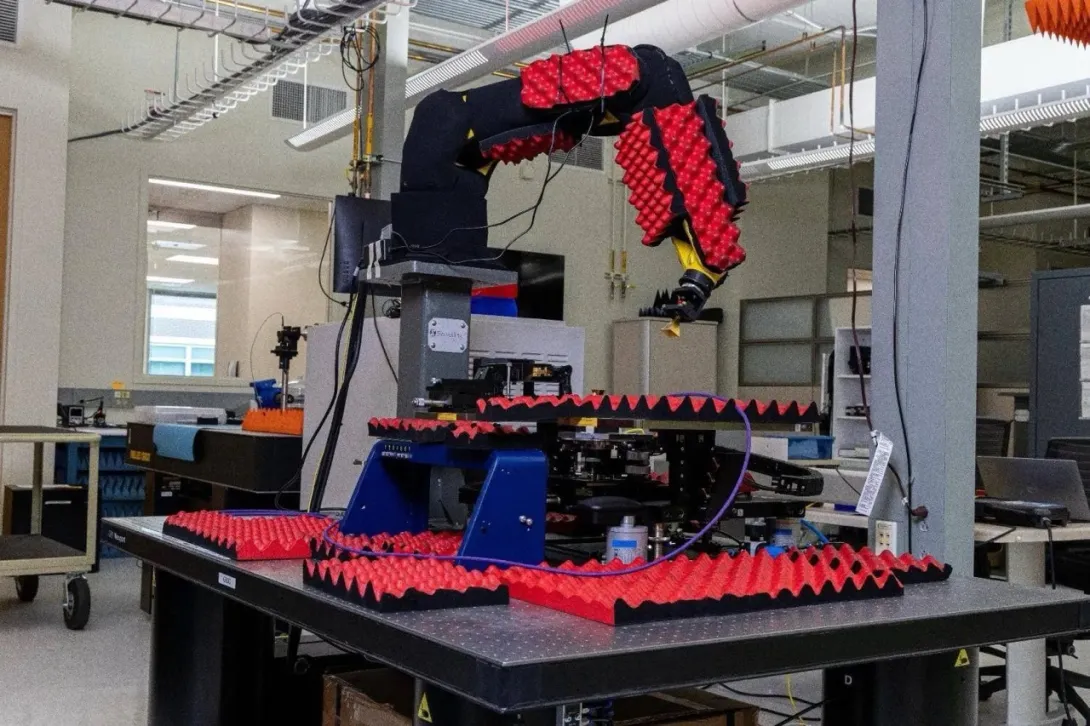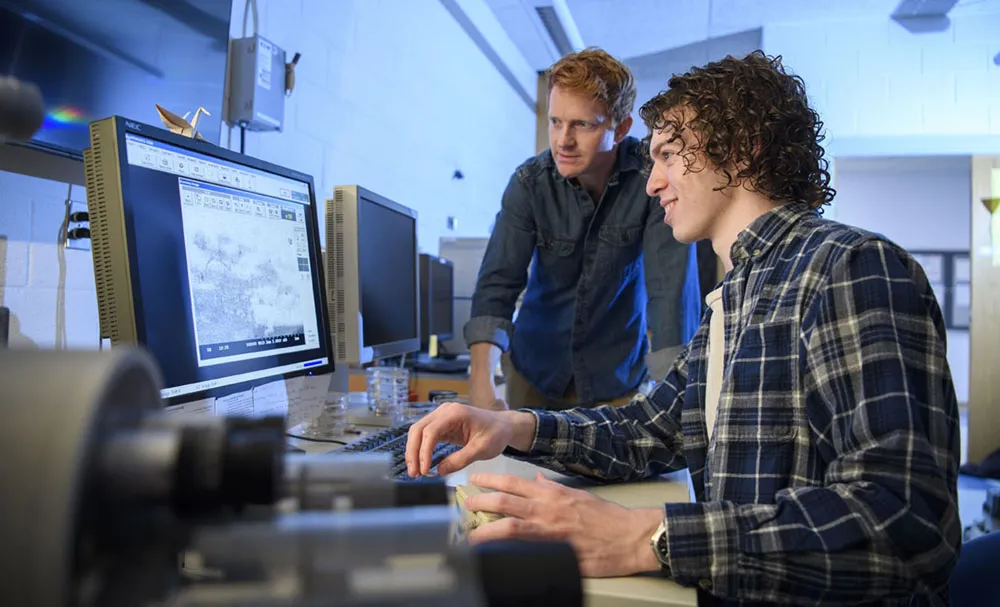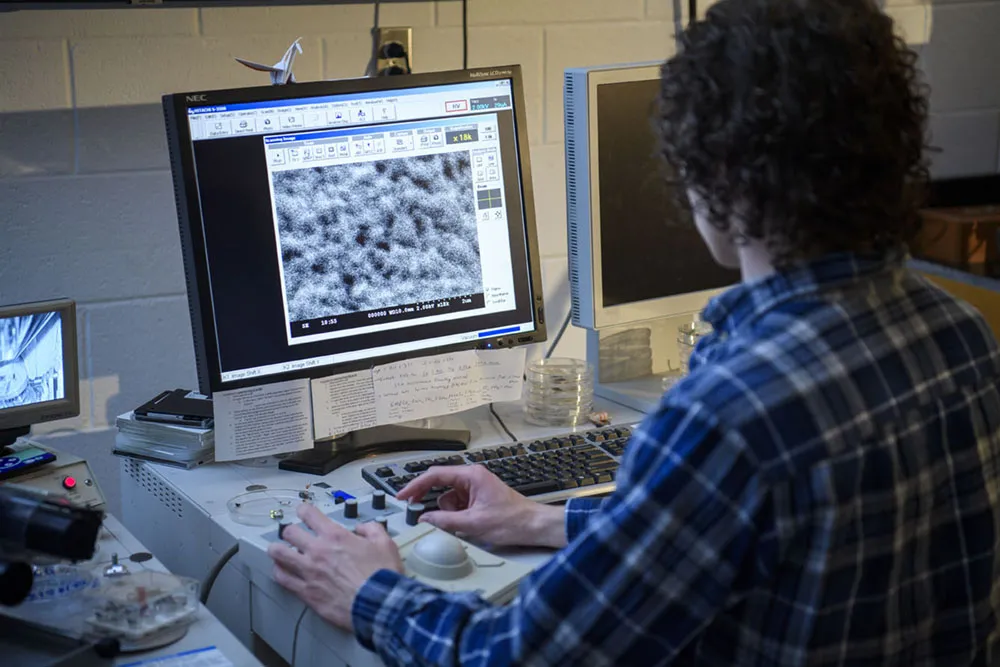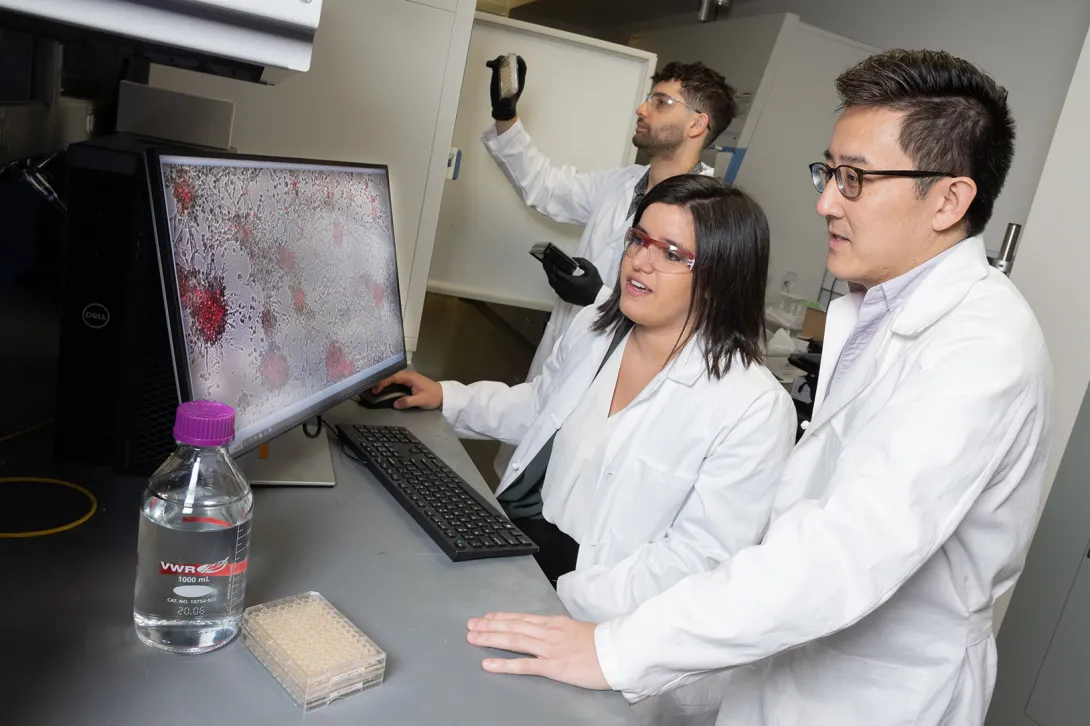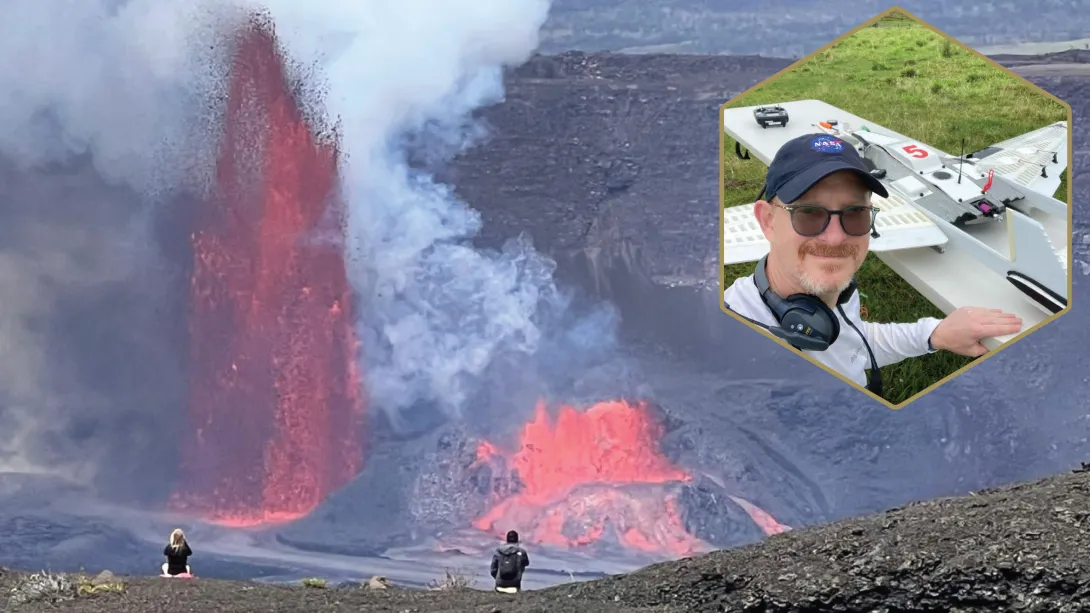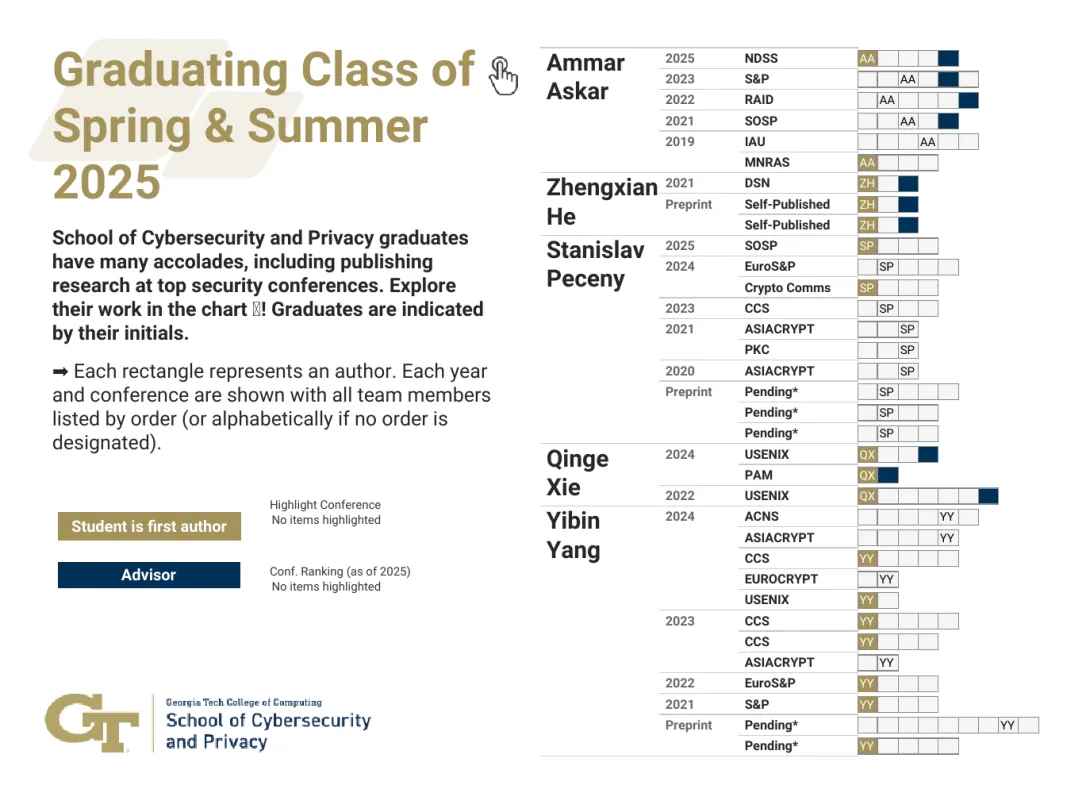Jun. 05, 2025
Aluminum scrap is one of the most common materials found on military bases and aircraft carriers worldwide. Now, the U.S. Army has tapped Georgia Tech to help turn that waste into power that can be generated off the grid and on demand.
The Army Research Office awarded Georgia Tech and its partners $20 million to develop scalable, efficient methods for transforming aluminum into hydrogen energy. The project could lead to a new, low-cost, clean, and efficient energy source powered by discarded materials.
Aaron Stebner, professor and Eugene C. Gwaltney Jr. Chair in Manufacturing in the George W. Woodruff School of Mechanical Engineering and professor in the School of Materials Science and Engineering, will oversee the multi-year effort at Georgia Tech together with Scott McWhorter, lead for Federal Initiatives at the Strategic Energy Institute.
In addition to several team members from Georgia Tech and the Georgia Tech Research Institute, the project includes researchers from Fort Valley State University, the 21st Century Partnership, MatSys, and Drexel University.
“Aluminum already reacts with water — even wastewater and floodwater — to create hydrogen gas, power, and thermal energy,” McWhorter said. “If aluminum can be efficiently upcycled into stored energy, it could be a game-changer.”
The team’s goal is to experiment with aluminum’s material properties so it can be inexpensively manufactured to create a highly effective reaction that produces low-cost, clean hydrogen.
“Having this ability would allow military bases to be less dependent on the use of a foreign country’s electrical grids,” said Stebner, who is also co-director of Georgia Artificial Intelligence in Manufacturing and faculty at the Georgia Tech Manufacturing Institute.
Manufacturing Aluminum
Several years ago, the Army Research Lab discovered and patented the basic technology for recycling aluminum to produce hydrogen gas. However, current manufacturing methods require too much energy for the amount of hydrogen energy produced.
To make the technology viable and effective, Stebner and his colleagues will research alternate manufacturing processes and then develop automated methods for safely producing and storing stable aluminum. They also plan to optimize these processes using digital twin technologies.
Currently, manufacturers use large machines to grind up and tumble the aluminum in very controlled environments, because stray aluminum powder can be explosive. These methods are very costly.
Stebner and the team are looking into small, modular technologies that could allow for convenient, onsite energy generation. According to Stebner, they are interested in determining how these smaller machines could be so efficient that they could be powered using solar panels.
Stebner envisions that a field of solar panels could power the aluminum-processing modules — the aluminum recycling could be done while the sun shines and produce power 24/7.
Sustainable Impact
Once they have developed the manufacturing techniques and processes, the team plans to test their efficacy by generating power for rural Georgia communities. Success here would prove the technology could be viable for military deployments and other off-grid scenarios.
“The Deep South — especially middle and southern Georgia, Alabama, Mississippi, and Louisiana — often has enormous energy disruptions during hurricanes or power outages due to flooding and severe rains,” Stebner said. “Manufacturers can be hesitant to build big plants there, because the grids aren’t as stable. This same technology that the Army plans to use for remote military bases could be a game-changer in rural Georgia.”
If power is unexpectedly cut in those areas, floodwater could then be used to make hydrogen gas. While hydrogen has not yet had its day in the sun, it has great potential as an alternative to fossil fuels, Stebner says.
“From a sustainability perspective, any time you can take something that’s already waste — like scrap aluminum and wastewater — and turn it into a high-value product that can be used to power communities, that is a huge win.”
Funding: Army Research Office
Jun. 05, 2025
Georgia Tech scientists have uncovered evidence that a mountain on the rim of Jezero Crater — where NASA’s Perseverance Rover is currently collecting samples for possible return to Earth — is likely a volcano. Called Jezero Mons, it is nearly half the size of the crater itself and could add critical clues to the habitability and volcanism of Mars, transforming how we understand Mars’ geologic history.
The study, “Evidence for a composite volcano on the rim of Jezero crater on Mars,” was published this May in the Nature-family journal Communications Earth & Environment, and underscores how much we have left to learn about one of the most well-studied regions of Mars.
Lead author Sara C. Cuevas-Quiñones completed the research as an undergraduate during a summer program at Georgia Tech; she is now a graduate student at Brown University. The team also included corresponding author Professor James J. Wray (School of Earth and Atmospheric Sciences), Assistant Professor Frances Rivera-Hernández (School of Earth and Atmospheric Sciences), and Jacob Adler, then a postdoctoral fellow at Georgia Tech and now an assistant research professor at Arizona State University.
“Volcanism on Mars is intriguing for a number of reasons — from the implications it has on habitability, to better constraining the geologic history,” Wray says. “Jezero Crater is one of the best studied sites on Mars. If we are just now identifying a volcano here, imagine how many more could be on Mars. Volcanoes may be even more widespread across Mars than we thought.”
A mountain in the margins
Wray first noticed the mountain in 2007, while considering Jezero Crater as a graduate student.
“I was looking at low-resolution photos of the area and noticed a mountain on the crater’s rim,” he recalls. “To me, it looked like a volcano, but it was difficult to get additional images.” At the time, Jezero Crater was newly discovered, and imaging focused almost entirely on its intriguing water history, which is on the opposite side of the 28-mile-wide crater.
Then, Jezero Crater, due to these lake-like sedimentary deposits, was selected as the landing spot for the 2020 Perseverance Rover — an ongoing NASA mission seeking signs of ancient Martian life and collecting rock samples for possible return to Earth.
However, after landing, some of the first rocks Perseverance encountered were not the sedimentary deposits one might expect from a previously-flooded area — they were volcanic. Wray suspected he might know the origin of these rocks, but to make a case for it, he would need to show that the mountain on the edge of Jezero Crater could indeed be a volcano.
A new researcher — and old data
The opportunity presented itself several months after Perseverance landed when Cuevas-Quiñones applied to a Summer Research Experience for Undergraduates (REU) program hosted by the School of Earth and Atmospheric Sciences to work with Wray.
“A previous study led by Briony Horgan (professor of planetary science at Purdue University) had also suggested that Jezero Mons could be volcanic,” Cuevas-Quiñones says. “I began wondering if there was a way to home in on these suspicions.”
The team partnered with study coauthor Rivera-Hernández, who specializes in characterizing the surface of planets and their habitability. They decided to use datasets gathered from spacecraft orbiting Mars to compare the properties of Jezero Mons to other, known, volcanoes. “We can’t visit Mars and definitively prove that Jezero Mons is a volcano, but we can show that it shares the same properties with existing volcanoes — both here on Earth and Mars,” Wray explains.
“We used data from the Mars Odyssey Orbiter, Mars Reconnaissance Orbiter, ExoMars Trace Gas Orbiter, and Perseverance Rover, all in combination to puzzle this out,” he adds. “I think this shows that these older spacecraft can be extremely valuable long after their initial missions end — these old spacecraft can still make important discoveries and help us answer tricky questions.”
For Cuevas-Quiñones, it also underscores the importance of REU programs and opportunities for undergraduates. “I was an undergraduate student at the time, and this was my first time conducting research,” she says. “It was fascinating to learn how different data sets could be used to decode the origin of a landscape. After Jezero Mons, it became clear to me that I would continue to study Mars and other planetary bodies.”
The search for life — and determining Mars’ age
The discovery makes the crater even more intriguing in the search for past life on Mars. A volcano so close to watery Jezero Crater could add a critical source of heat on an otherwise cold planet, including the potential for hydrothermal activity — energy that life could use to thrive.
This type of system also holds interest for Mars as a whole. “The coalescence of these two types of systems makes Jezero more interesting than ever,” shares Wray. “We have samples of incredible sedimentary rocks that could be from a habitable region alongside igneous rocks with important scientific value.” If returned to Earth, igneous rocks can be radioisotope dated to know their age very precisely. Dating the Jezero Crater samples could be used to calibrate age estimates, providing an unprecedented window into the geologic history of the planet.
The take home message? “Mars is the best place we have to look in our solar system for signs of life, and thanks to the Perseverance Rover collecting samples in Jezero, the United States has samples from the best rocks in the best place on Mars,” Wray says. “If these samples are returned to Earth, we can do incredible, groundbreaking science with them.”
DOI: https://doi.org/10.1038/s43247-025-02329-7
Funding: Cuevas-Quiñones was supported by Georgia Tech’s 2021 Research Experience for Undergraduates program sponsored by NSF and 3M corporation. Wray was supported by NASA funding for Co-Investigators on HiRISE and CaSSIS. CaSSIS is a project of the University of Bern and funded through the Swiss Space Office via ESA’s PRODEX program. The instrument hardware development was also supported by the Italian Space Agency (ASI) (ASI-INAF agreement 2020-17-HH.0), INAF/Astronomical Observatory of Padova, and the Space Research Center (CBK) in Warsaw. Support from SGF (Budapest), the University of Arizona Lunar and Planetary Lab, and NASA are also gratefully acknowledged. Operation support from the UK Space Agency is also acknowledged.
News Contact
Written by Selena Langner
May. 28, 2025
Thomasville, Georgia, is a hub of training and talent for local manufacturers. But Mason Miller could tell there was something missing.
“We didn't have any training for advanced manufacturing in our area,” said Miller, vice president of Academic Affairs at Southern Regional Technical College (SRTC), which offers education and training programs in technical and manufacturing fields. “Companies had to go out and recruit people from Michigan to run their machines. That's when we said, ‘We don’t want that to happen — we need to be doing that right here.’”
That’s where the Georgia Tech Manufacturing Institute (GTMI) stepped in. Working with partner program Georgia Artificial Intelligence in Manufacturing (Georgia AIM), GTMI helped connect SRTC with the resources and expertise needed to develop a robust training program tailored to the needs of local manufacturers.
Miller said at first, he was skeptical. “When GTMI said they wanted to be partners, I thought, ‘OK, this is another situation where we're going to talk for a minute, everybody says things and then goes away — and that’s it,’” said Miller. “That's not how it's been at all.”
Rather, it’s been a true partnership driven by SRTC, with curriculum focused on automation and robotics developed by the Technical College System of Georgia and GTMI. The curriculum is also shaped by local industry input to directly address workforce gaps in the region’s manufacturing sector.
“As a state institution, we're here to serve you,” said Steven Sheffield, senior assistant director of Research Operations at GTMI and a point person of the partnership. “Tell us the problem, and we will work hard to try to solve it with you.”
Filling the Workforce Gap
Miller was committed to giving SRTC students the advanced manufacturing skills needed to stand out in the workforce. Yet the evolving manufacturing landscape and the needs of local manufacturers revealed gaps in SRTC’s curriculum, particularly in AI, automation, and robotics.
With GTMI and Georgia AIM researchers contributing key expertise to the expanded smart manufacturing curriculum, Miller noted the partnership is “opening our eyes to what we can do with AI. We're going to start integrating that into our programs.”
Beyond AI and robotics, SRTC leadership identified a crucial gap in their program: training in precision machining, a skill that local manufacturers like Check-Mate Industries sorely needed.
“If we want to attract new business and industry to Georgia, we need to be able to show them we can provide a skilled workforce,” said Miller.
To address this missing piece, GTMI and Georgia AIM helped procure funding to acquire and refurbish precision-machining equipment from longtime partner Makino. Georgia AIM also supported the renovation and outfitting of two SRTC lab spaces with additional updated equipment.
Last fall, SRTC launched its new Precision Manufacturing & Engineering and Manufacturing Engineering Technology programs, with instructors trained by GTMI faculty in precision manufacturing. The new program at SRTC is one example of the ways GTMI experts are working with communities across the state to expand access to training and new technology.
“Not a lot of technical colleges have this type of machinery,” said Marvin Bannister, SRTC precision machining and manufacturing program chair. Instructors like Bannister received specialized training at GTMI’s Advanced Manufacturing Pilot Facility to ensure they felt confident teaching students how to operate the machinery. “Not only is it something else to add to my skill set, but the most important thing is that I'll be able to train other students who desire to learn on a machine like this.”
Because of SRTC’s expanded offerings, the technical college has strengthened partnerships and developed new internship programs with local manufacturers. “We all want the same thing,” said Miller, “which is to grow industry partnerships and to create a talent pipeline for our state.”
GTMI and Georgia AIM also support STEM programs with Thomasville area schools and internship programs for K-12 teachers with local manufacturers such as Check-Mate. These efforts deepen the connections between students and manufacturers, opening doors to future careers in the sector.
“We’re here to connect the dots and enable these types of partnerships,” says Steven Ferguson, a principal research scientist with GTMI and co-director of Georgia AIM. “When teams and their networks come together to solve a challenge for just one manufacturer, the impact can reach across an entire region.”
News Contact
Audra Davidson
Research Communications Program Manager
Georgia Tech Manufacturing Institute
May. 28, 2025
In today’s world, the search for viable, climate-friendly energy sources is a major focus of scientific research. Eric Vogel, Hightower Professor in the School of Materials Science and Engineering and executive director of the Institute for Matter and Systems at Georgia Tech, is contributing to this effort through a $107 million project funded by the U.S. Department of Energy. The project, in collaboration with the Savannah River National Laboratory (SRNL), aims to make fusion energy a commercially viable option.
News Contact
Anastasia Slaughter | School of Materials Science and Engineering
May. 28, 2025
Georgia Tech researchers played a key role in the development of a groundbreaking AI framework designed to autonomously generate and evaluate scientific hypotheses in the field of astrobiology. Amirali Aghazadeh, assistant professor in the school of electrical and computer engineering, co-authored the research and contributed to the architecture that divides tasks among multiple specialized AI agents.
This framework, known as the AstroAgents system, is a modular approach which allows the system to simulate a collaborative team of scientists, each with distinct roles such as data analysis, planning, and critique, thereby enhancing the depth and originality of the hypotheses generated
News Contact
Amelia Neumeister | Research Communications Program Manager
The Institute for Matter and Systems
May. 28, 2025
Nestled on the fifth floor of Georgia Tech's Technology Square Research Building (TSRB), the mmWave Antennas & Arrays Lab is silently innovating in wireless communication. Under the leadership of professor Nima Ghalichechian, the lab is at the forefront of developing technologies that promise to revolutionize how we connect and communicate.
Read the full story from Tech Sqaure ATL .
News Contact
Amelia Neumeister | Research Communications Program Manager
The Institute for Matter and Systems
May. 27, 2025
For many researchers, access to advanced instrumentation and toolsets can be the difference between an idea and getting published. But not all academic institutions can prioritize research instrumentation on the same scale.
Jacob Sylvie, an undergraduate researcher at Berry College, experienced this firsthand. His research focused on developing benchtop electrochemical methods to grow crystalline semiconductor materials — work that required highly specialized techniques and tools. Even though Sylvie performed most of his research at Berry, he still had one problem: He needed access to resources that weren’t available on campus.
“Since Berry College is a small, liberal arts, primarily undergraduate institution, we only have access to a limited range of in-house instrumentation,” said Zachary Lindsey, assistant professor at Berry College and Sylvie’s advisor. “The combination of the available instrumentation and focused support offered by expert personnel at Georgia Tech presented a rare, world-class opportunity for my students.”
Sylvie and Lindsey reached out to the Institute for Matter and Systems’ Materials Characterization Facility regarding characterization services. They were advised to apply for the Southeastern Nanotechnology Infrastructure Corridor (SENIC) Catalyst Program to support Sylvie’s research needs.
The program supports researchers in microtechnology, nanotechnology, and the broader scientific community by providing access to SENIC facilities to aid in research, obtain preliminary data, conduct proof-of-concept studies, or for educational purposes.
“One of the goals of SENIC is to democratize access to world-class facilities, like the ones here at IMS,” said David Gottfried, associate director of external user programs and SENIC site director at Georgia Tech. “The Catalyst Seed Grants are one way we can make sure that anyone can benefit from our research infrastructure.”
Through the program, Sylvie and Lindsey received use-of-tool access, staff time, and materials and supplies for six months. During this time, Sylvie published his first peer-reviewed article in Physica B: Condensed Matter. The publication played a pivotal role in his successful application for the Goldwater Scholarship in March.
“I cannot emphasize enough the magnitude of the support and efficiency of the SENIC Catalyst Seed Grant,” said Lindsey. “The impact that this program has had on my students and me is irreplaceable, and I highly recommend that other faculty and students take advantage of this opportunity to push your research to new heights.”
Programs like SENIC don’t just support research — they bridge the gap between potential and achievement, empowering students from all backgrounds to reach new heights in science and innovation.
This work was performed in part at the Georgia Tech Institute for Matter and Systems, a member of the National Nanotechnology Coordinated Infrastructure (NNCI), which is supported by the National Science Foundation (Grant ECCS-2025462).
News Contact
Amelia Neumeister | Research Communications Program Manager
The Institute for Matter and Systems
May. 16, 2025
Biomedical engineers at Georgia Tech created a treatment that could one day unlock a universal strategy for treating some of the hardest-to-treat cancers — like those in the brain, breast, and colon — by teaching the immune system to see what it usually misses.
Their experimental approach worked against those kinds of cancers in lab tests and didn’t damage healthy tissues. Importantly, it also stopped cancer from returning.
While the therapy is still in early stages of development, it builds on well established, safe technologies, giving the treatment a clearer, quicker path to clinical trials and patient care.
Reported in May in the journal Nature Cancer, their technique is a one-two punch that flags tumor cells so they can be recognized and then eliminated by specially enhanced T cells from the patient’s own immune system.
News Contact
Joshua Stewart
College of Engineering
May. 16, 2025
As Rocket Lab prepares to launch a mission to Venus next year, a multidisciplinary research team led by Georgia Tech braved an erupting volcano recently to test an instrument custom-built to explore Venus’ clouds and look for signs of organic chemistry. If successful, the 2026 launch will mark the first private spacecraft to reach Venus, and the first U.S. mission to study its sulfuric acid-filled clouds in nearly 40 years.
The instrument, the autofluorescence nephelometer (AFN) built by Droplet Measurement Technologies, will fire a laser beam out a window and use light scattering from individual particles to measure the size and composition of the planet’s aerosols, the tiny particles that make up the clouds. The AFN will only have about five minutes to collect data as the small probe falls through the clouds, and another 15 minutes to send data back to Earth before things get too extreme. The probe is not expected to reach the surface, where it is hot enough to melt lead, and the pressure is 90 times that of Earth’s surface.
Georgia Tech oversees all of the instrument’s field tests and modeling. The project, called VENUSIAN, is led by Christopher E. Carr, assistant professor in the Daniel Guggenheim School of Aerospace Engineering, with funding from NASA’s PSTAR program. Carr holds a joint appointment in the School of Earth and Atmospheric Sciences.
NASA also built a heat shield for Rocket Lab’s spacecraft and will provide navigation and communications support through the Deep Space Network.
“Is there life in the clouds of Venus? I don’t think so, but if it’s there, I want to find it,” says Carr, who admits that the more he studies Venus, the more interesting it becomes.
Collecting Volcanic Molecules
In March, his team tested the AFN in the field, flying it on a drone through Hawaii’s volcanic fog, a haze that forms because of volcanic emissions. The droplets are rich with sulfuric acid, similar to Venus’ atmosphere.
“We got some valuable data,” says Carr. “This was the first time for our whole team from different institutions to be together in one place.”
Collaborators from the Massachusetts Institute of Technology (MIT), the University of Colorado-Boulder, which managed and flew the drones, and Droplet Measurement Technologies joined the Georgia Tech contingent in Hawaii.
Sara Seager, professor of physics, professor of aeronautics and astronautics, and Class of 1941 Professor of Planetary Science at MIT, who serves as the science principal investigator for the Rocket Lab mission, emphasized the critical testing role Georgia Tech is playing ahead of the mission to Venus.
“Building the instrument is important, but what is also important is knowing how you’re going to interpret data when you get back. To understand that you need to use the instrument over and over again here on Earth. Professor Carr taking a lead on that from a science perspective is important,” says Seager, who will oversee two subsequent Morning Star Missions to Venus that the team envisions will culminate in an atmosphere sample return.
The Kilauea volcano, located in Hawaii Volcanoes National Park on the Big Island, began erupting as soon as the team started their first drone flight. The eruption grew more intense on the second day, giving the researchers a chance to run the AFN through its paces. While the flight test results are still preliminary, the team indicated that the instrument did detect volcanic ash and volcanic smog, which bodes well for the Venus mission.
“It was cool to see our instrument in action,” says Snigdha Nellutla, a research engineer and data modeler, who recently finished her master’s in aerospace engineering. She simulates the AFN’s output in different environmental conditions, both during the Hawaii field tests and on the actual mission to Venus.
In Search of a Carbon Cycle
“We’re seeking evidence of a carbon cycle in the Venus atmosphere,” she said. “Life as we know it on Earth is carbon-based. Carbon compounds are delivered to Venus from meteorites. Are they rapidly degraded or do they persist in some form?”
Billions of years ago, Venus may have had as much water as Earth — but at some point in its evolution, carbon dioxide in the planet's atmosphere triggered an intense runaway greenhouse effect. This sent temperatures soaring, causing the planet's water to evaporate, and the hydrogen part of the water (H2O) was lost to space.
In 2020, astronomers detected phosphine in Venus’ atmosphere. This gas, often associated with biological activity on Earth, could signal signs of life. While the presence of phosphine is now debated, a rash of recent discoveries suggests that organic chemistry in the clouds could be much more complex than previously considered.
While Venus’ extreme surface temperatures are well documented, the one exception is found in the middle cloud layers, which have habitable temperatures. By looking at individual particles within the Venus atmosphere, researchers hope to learn about other compounds that could exist, including organic molecules that could influence a carbon cycle. The Hawaii measurements will serve as an important baseline to compare against what will be gathered on Venus.
The Smoking Gun of Organics
The mission to Venus will also measure fluorescence, considered “a smoking gun” for possible organic materials, says Carr.
On Venus’ super-rotating atmosphere, clouds take four Earth days to travel around the planet, while the planet spins in the same direction approximately 50 times slower.
“The differences with Venus’s atmosphere compared with Earth have forced our whole team to look at how we approach astrobiology completely differently,” he explains. “When we think of finding signs of life, we follow the water, but Venus has no water; it’s sulfuric acid.”
To Carr, the importance of the mission is to better understand Venus’ chemistry, given that sulfuric acid and water have different properties, which can contribute to or limit the kind of chemistry that can occur.
“By understanding what might be possible, we can learn if different types of life might be possible. It also helps us know what to look for when we look for life,” he says. Even if there is no life in the clouds of Venus, there is likely to be interesting chemistry, based on extensive testing by members of the science team. This chemistry could be detected by the AFN as fluorescent aerosol particles.
VENUSIAN has enabled Georgia Tech aerospace engineering students to get a rare opportunity to test and model hardware that will fly in space.
Students Celebrate Teamwork, Space Aspirations
“As a first-year, I’ve had a variety of tasks, and that’s been fun for me as someone who is just starting to explore my career possibilities,” says Violet Oliver, who oversees the ground sampling tests. “This has been a really good introduction — getting my feet wet in what future space missions might look like and, more broadly, what the engineering test cycle looks like.”
“The biggest thing we learned was how to work together as a team,” adds Cassius Tunis, a senior in aerospace engineering. He managed the logistics, designed hardware to integrate the AFN and the drone, and served as the field study’s test engineer during the flights, where he communicated with the pilots and tracked their flight pattern.
“It’s been a goal of mine to work in the space industry since high school,” he said, crediting VENUSIAN with helping him pinpoint his career direction. “I see myself as the resident test engineer. Test engineering is a very operational, multidisciplinary field within aerospace. You get to wear a lot of different hats and interact with people of all different backgrounds.”
Carr indicated that the team will return to Hawaii later this year for final AFN field testing before the Venus mission.
Looking to the 2026 launch, Seager says, “I’m looking forward to a safe launch and getting exciting data back. It’s Venus’ moment to shine,” she added, calling Venus the “quiet, overlooked gem” to Mars and Earth.
Carr expressed admiration for Rocket Lab’s founder and CEO, Peter Beck, whose passion for the Venus mission is well documented.
“He exudes the true curiosity of a scientist and explorer. In Rocket Lab, we have a partner that is excited by discovery.”
May. 14, 2025
The School of Cybersecurity and Privacy at Georgia Tech is proud to recognize the accomplishments of five doctoral students who finished their doctoral programs in Spring 2025. These scholars have advanced critical research in software security, cryptography, and privacy, collectively publishing 34 papers, most of which appear in top-tier venues.
Ammar Askar developed new tools for software security in multi-language systems, including a concolic execution engine powered by large language models. He highlighted DEFCON 2021, which he attended with the Systems Software and Security Lab (SSLab), as a favorite memory.
Zhengxian He persevered through the pandemic to lead a major project with an industry partner, achieving strong research outcomes. He will be joining Amazon and fondly remembers watching sunsets from the CODA building.
Stanislav Peceny focused on secure multiparty computation (MPC), designing high-performance cryptographic protocols that improve efficiency by up to 1000x. He’s known for his creativity in both research and life, naming avocado trees after famous mathematicians and enjoying research discussions on the CODA rooftop.
Qinge Xie impressed faculty with her adaptability across multiple domains. Her advisor praised her independence and technical range, noting her ability to pivot seamlessly between complex research challenges.
Yibin Yang contributed to the advancement of zero-knowledge proofs and MPC, building toolchains that are faster and more usable than existing systems. His work earned a Distinguished Paper Award at ACM CCS 2023, and he also served as an RSAC Security Scholar. Yang enjoyed teaching and engaging with younger students, especially through events like Math Kangaroo.
Faculty mentors included Regents’ Entrepreneur Mustaque Ahamad, Professors Taesoo Kim and Vladimir Kolesnikov, and Assistant Professor Frank Li, who played vital roles in guiding the graduates’ research journeys.
Learn more about the graduates and their mentors on the 2025 Ph.D. graduate microsite.
News Contact
JP Popham, Communications Officer II
College of Computing | School of Cybersecurity and Privacy
Pagination
- Previous page
- 4 Page 4
- Next page

